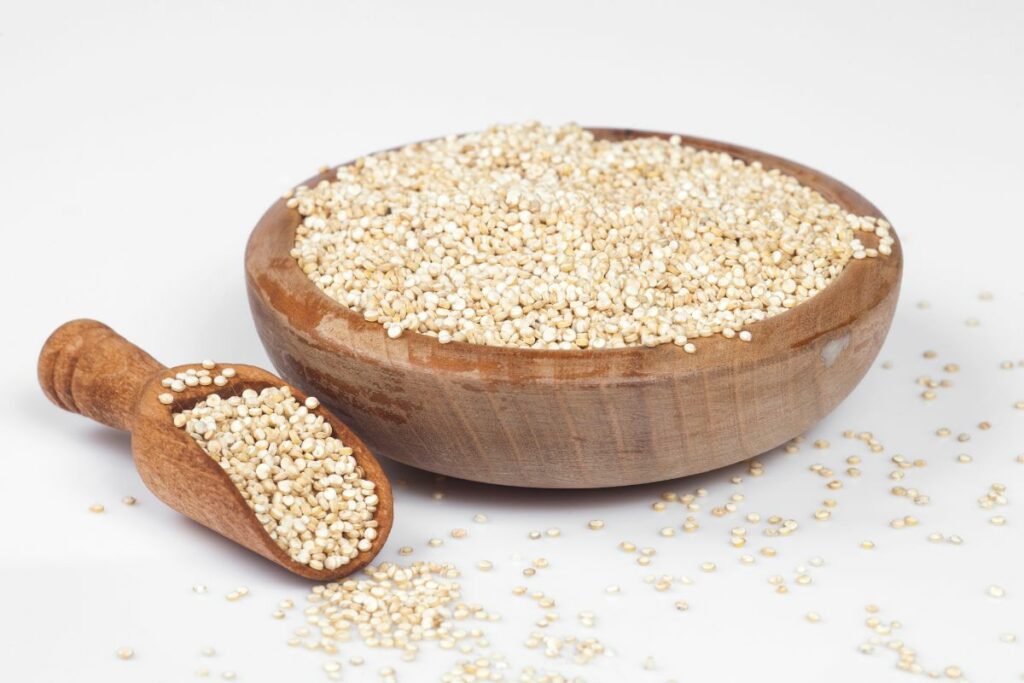You may not think of whole grains as a go-to for low-calorie meals, but like any food, it’s all about portions and your method of cooking.
If you’re counting calories, consider Millet, Quinoa, Oats, Barley, Brown rice, Rye, and Buckwheat. These are great grain options because they are nutritional powerhouses while also being lower in calories, when compared to other grains.
Here’s a quick comparison chart to help you meet your personal dietary goals:
| Nutrient (per 1/2 cup dry) | Oats | Millet | Quinoa | Barley | Brown Rice | Rye | Buckwheat |
|---|---|---|---|---|---|---|---|
| Calories | 154 | 206 | 318 | 326 | 344 | 337 | 335 |
| Carbohydrates (g) | 27 | 41 | 58 | 72 | 76 | 72 | 71 |
| Fiber (g) | 4 | 2.2 | 5 | 14 | 3.5 | 15 | 6 |
| Protein (g) | 5 | 4.1 | 6 | 8 | 7 | 12 | 12 |
| Fat (g) | 3 | 1.7 | 5 | 2 | 2 | 2 | 2 |
| Magnesium (mg) | 69 | 59 | 89 | 45 | 85 | 121 | 231 |
| Phosphorus (mg) | 185 | 140 | 318 | 176 | 200 | 337 | 347 |
| Iron (mg) | 1.7 | 1.7 | 2.8 | 2.5 | 1.5 | 1.8 | 2.2 |
| Zinc (mg) | 1.3 | 0.7 | 2.1 | 1.3 | 2 | 2.7 | 2 |
| Potassium (mg) | 164 | 195 | 318 | 293 | 220 | 348 | 460 |
| Best uses | Oatmeal hot cereal, blended into smoothies, Substitute in baking | In pilafs or as a side dish | Base for grain bowls, add to soups and stews, Quinoa salad | Add to soups and stews, risottos, barley salads | As a side dish, in stir-fries, mixed with veggies and protein | Add to bread recipes, use in sourdough bread, as a side dish | Buckwheat groats for hot cereal, salads, substitute up to 25% of baked goods wheat with Buckwheat flour |
Here’s some more detail on each whole grain and why you should consider trying them in your next meal.
1. Oats
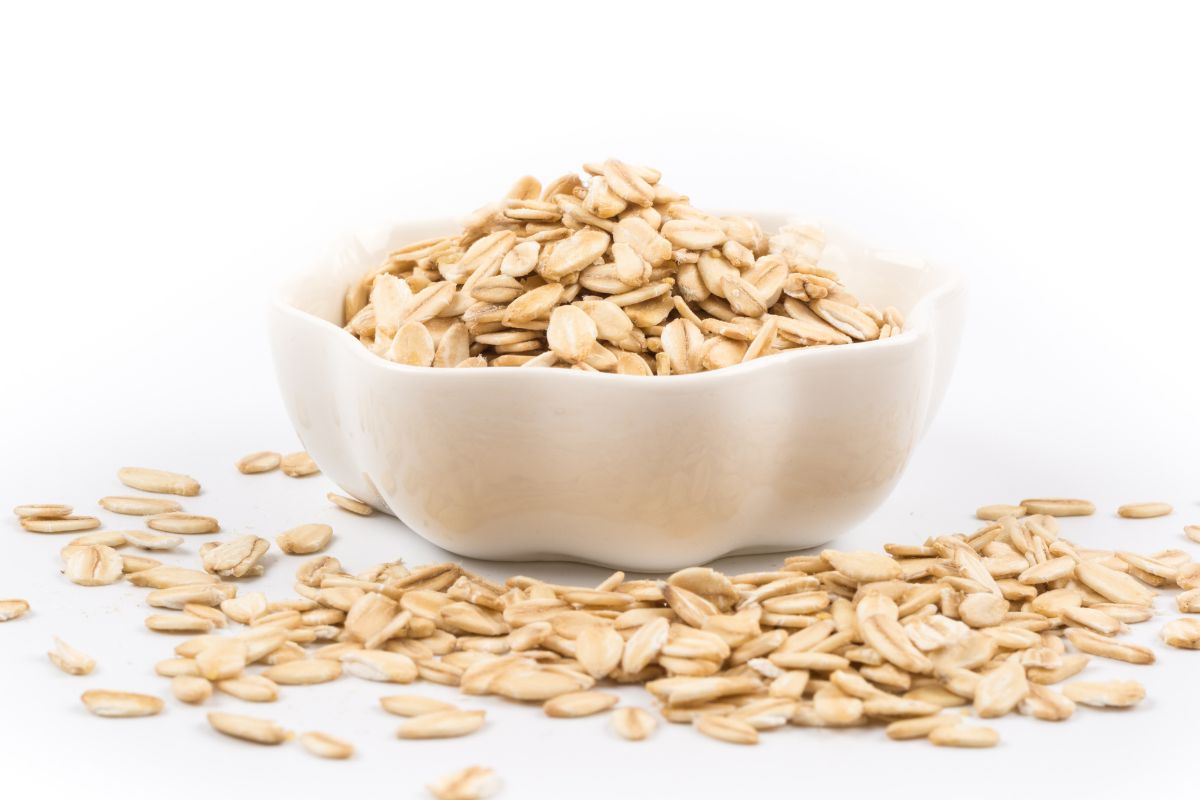
Oats is the lowest calorie grain. They are excellent to eat when you are on a diet, since you can eat a larger amount of them for fewer calories than comparable grains.
There are a number of different benefits to eating oats. For starters oats contain high amounts of avenanthramide which is a type of antioxidant, great for your cardiovascular health.
In addition to that, oats are very high in fiber – in specific, beta glucan fiber. This kind of fiber is known particularly for its efficiency in absorbing high levels of water.
Because of this, when you eat oats they start to swell inside of your stomach and this can make you feel much fuller overall. This makes you less inclined to try to eat more, making them a fantastic choice if you are trying to lose weight.
If you think oats are just for oatmeal, think again. Here are some alternative ideas to incorporate more oats into your meals:
- Oat pancakes: Create a wholesome pancake by combining 1 ripe banana, 2 tablespoons quick oats, 1 large egg, and 2 tablespoons chopped pecans or your favorite nut. Cook like pancakes!
- Oat smoothie bowl: Blend oats with your favorite smoothie ingredients to create a thick smoothie bowl. Top with granola, sliced fruits, and shredded coconut
- Oat and yogurt parfait: Layer oats, Greek yogurt, and a mixture of berries or chopped fruits
- Homemade granola: Bake oats with honey, nuts, seeds, and dried fruits to make your own granola. Enjoy it as a topping for yogurt, smoothie bowls, or as a crunchy snack
- Oat energy bites: Mix oats with nut butter, honey, and add-ins like chocolate chips, chopped nuts, and dried fruits. Form into bite-sized balls for a convenient and energy-boosting snack.
- Oat crusted chicken or fish: Use oats to create a crispy coating for baked chicken or fish. Dip the protein in egg or buttermilk, then coat with seasoned oats before baking
- Oat and vegetable soup thickener: Blend oats with water or broth and use the mixture as a natural thickener for soups. It adds a creamy texture and can help make soups heartier
- Oat-based savory bowl: Create a savory oat bowl by topping cooked oats with sautéed vegetables, a fried or poached egg, and a sprinkle of cheese or herbs
Learn more about Oats here.
2. Millet
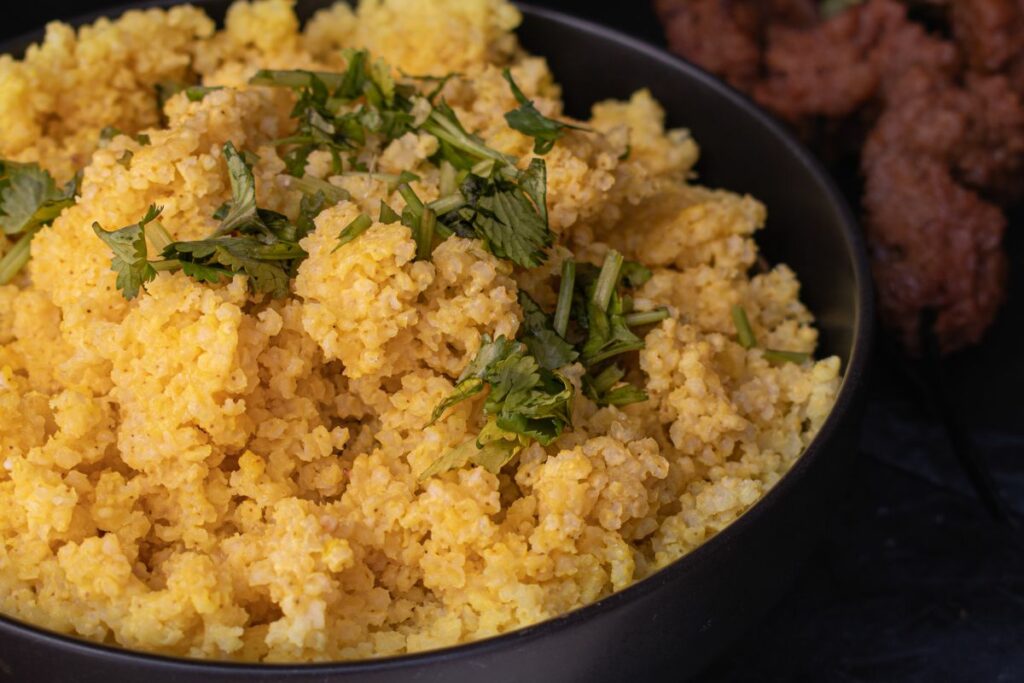
Millet comes in at the second-lowest calorie density of whole grains. It provides satiety and energy without packing in excessive calories, making it a great choice for low-calorie meals. It’s also relatively high in dietary fiber, which adds bulk to your meals, promoting a feeling of fullness and helping control appetite.
Millet also has a low glycemic index, which means it has a smaller impact on blood sugar levels. This can be beneficial for managing blood sugar and avoiding rapid spikes and crashes in energy. And, Millet is naturally gluten-free, making it suitable for those with gluten sensitivities or Celiac Disease.
Need some meal inspiration? Here is how you can enjoy Millet:
- Millet hot cereal: Cook millet with water or milk to create a creamy breakfast hot cereal. Top it with fresh berries and a drizzle of honey or maple syrup
- Millet salad: Cook millet to package directions and let it cool. Mix it with chopped cucumbers, tomatoes, bell peppers, red onion, and fresh herbs. Toss with a lemon vinaigrette
- Millet stir-fry: Use cooked millet as the base for a vegetable stir-fry. Sauté your favorite vegetables with a lean protein and season with stir-fry sauce (½ cup soy sauce, ½ cup broth, 1 teaspoon sesame oil, ½ Tablespoon rice vinegar, 2 cloves minced garlic, 2 teaspoons grated ginger, 1 Tablespoon cornstarch, Pinch red pepper flakes). Serve over a bed of millet
- Millet breakfast bowl: Create a breakfast bowl by layering cooked and cooled millet with Greek yogurt, sliced bananas, chia seeds, and a drizzle of nut butter for added protein and healthy fats
- Millet soup: Add millet to your favorite soup for an extra boost of texture and nutrients. Millet can help thicken the soup slightly and make it more satisfying
- Millet tabbouleh: Make a Mediterranean-inspired tabbouleh salad using millet instead of bulgur wheat. Mix cooked millet with finely chopped parsley, tomatoes, cucumbers, red onion, lemon juice, and olive oil
- Millet pilaf: Used just like rice, but with Millet instead! Check out this recipe that combines carrots, saffron, and onions for a tasty side dish
- Millet sides: Serve cooked millet as a side dish alongside grilled chicken, fish, or roasted vegetables. Flavor it with herbs like thyme or rosemary and a drizzle of olive oil
Read more about Millet here.
3. Quinoa

Quinoa is a food that’s becoming more and more popular as time goes on, and it’s not difficult to see why. This delicious grain comes with a lot of different health benefits. In just 1/2 cup of uncooked quinoa you will get just 318 calories.
This grain is especially beneficial if you are following a vegan diet or primarily eat plant based foods, since it’s quite high in protein and amino acids.
The benefits don’t stop there, either. Eating quinoa may actually lower your chances of getting chronic diseases thanks to the anti-inflammatory phytonutrients in it. It also contains a lot of omega 3 fatty acids and is great for helping you to lose weight thanks to the low calories and high protein content.
It’s a good grain if you want to keep your blood sugar balanced, and it’s even suitable for consumption if you have coeliac disease or an intolerance to gluten.
Quinoa is much more versatile than as a side dish your kids probably won’t want to eat. Here are some new ways to enjoy Quinoa:
- Quinoa salad: Mix cooked quinoa with your favorite protein (like chicken), diced cucumbers, cherry tomatoes, red onion, and chopped fresh herbs. Toss with a lemon-herb vinaigrette
- Quinoa breakfast bowl: Use cooked and cooled quinoa in lieu of granola by combining it with Greek yogurt, mixed berries, a sprinkle of nuts, and a drizzle of honey for sweetness
- Quinoa stuffed bell peppers: Prepare a filling by mixing cooked quinoa with lean ground turkey, black beans, corn, diced tomatoes, and spices. Stuff bell peppers with the quinoa mixture, top with cheese, and bake at 350 degrees F until peppers are tender
- Quinoa and roasted vegetable bowl: Roast a variety of vegetables (such as sweet potatoes, broccoli, and bell peppers) and serve them over a bed of cooked Quinoa with your favorite protein. Drizzle with tahini dressing for added flavor
- Quinoa and black bean burrito bowl: Layer cooked Quinoa with black beans, sautéed fajita meat and veggies (onions/sweet peppers), salsa, sliced avocado, and a dollop of Greek yogurt or sour cream
- Quinoa minestrone soup: Add cooked quinoa to a classic minestrone soup for extra texture and protein
Read more about Quinoa here.
4. Barley

Barley is another whole grains that is great weight loss due to its low calorie content but is often not considered outside of beer-making.
Note that you want to stay away pearled barley since this is refined barley – instead, you want to be buying whole grain barley.
Barley’s chewy texture and nutty flavor lend it a variety of dishes. If you want to try out barley, here are some meal ideas that showcase different ways to incorporate Barley into your meal plans:
- Barley vegetable soup: Use barley as the main ingredient in a hearty vegetable soup. Combine Barley with carrots, celery, tomatoes, and spinach
- Mushroom Barley risotto: Make a creamy risotto-style dish by cooking barley with mushrooms, onions, and broth. Finish with a touch of butter (optional to limit calories) or grated Parmesan cheese for richness
- Barley and roasted vegetable bowl: Roast a variety of vegetables like sweet potatoes, bell peppers, and zucchini. Serve them over a bed of cooked barley and drizzle with a tahini dressing. Pair with chicken thighs for added protein
- Barley and chicken casserole: Layer cooked barley with cooked chicken, sautéed vegetables, and a light cream sauce. Top with breadcrumbs and bake until golden
- Barley and lentil stew: Make a hearty stew by combining cooked Barley with brown lentils, carrots, celery, and diced tomatoes. Add herbs and spices
- Barley and spinach salad: Toss cooked and cooled barley with fresh baby spinach, crumbled feta cheese, toasted nuts, and a balsamic vinaigrette
- Barley and beef stir-fry: Sauté thin slices of beef with colorful bell peppers, onions, and broccoli. Add cooked Barley and a savory stir-fry sauce
Learn more about Barley here.
5. Buckwheat
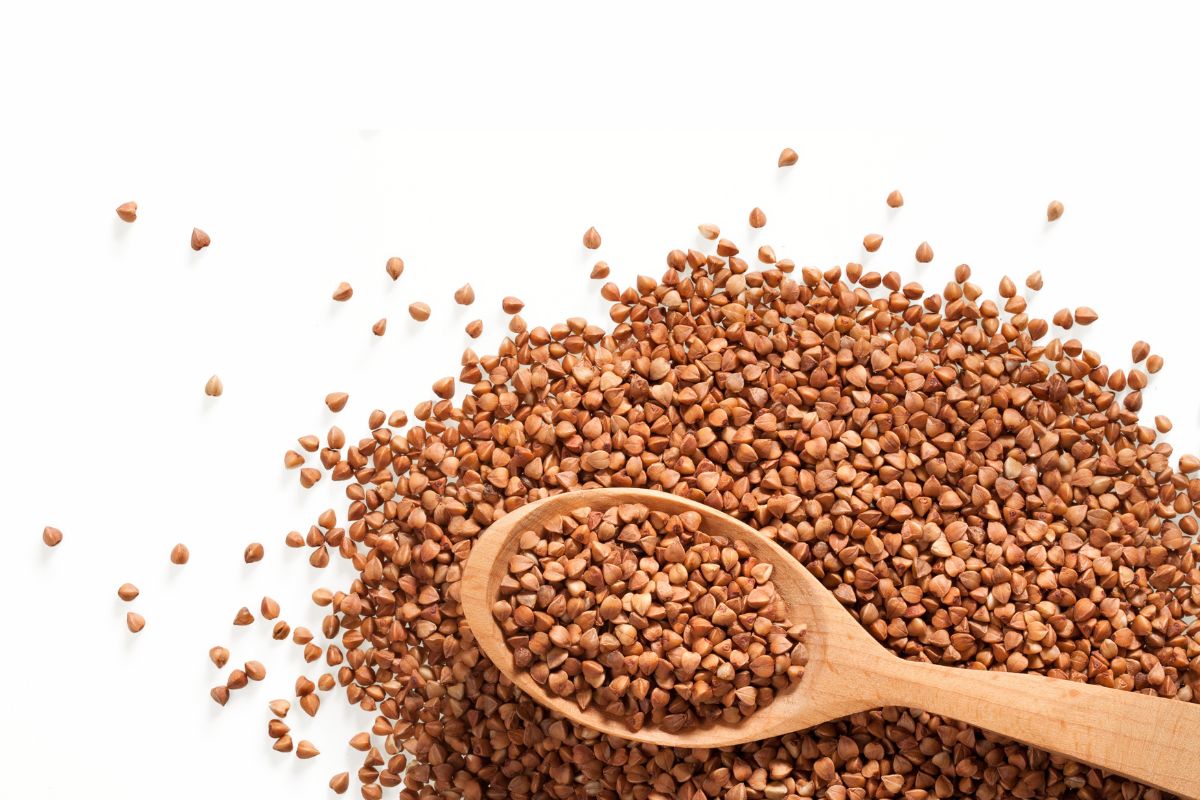
One fantastic grain to eat if you are looking for something that is low in calories is Buckwheat. I’ve been on a Buckwheat kick lately and it’s been fun to figure out different ways to enjoy it.
Buckwheat is technically a seed which originates from the Fagopyrum esculentum plant. I think of it as a triangle-shaped sunflower seed as it has a black hull and tan-colored “meat” called a groat. When you’re shopping for Buckwheat you’ll find it in four different forms:
- Whole Buckwheat: Contains the hull, which is black in color
- Buckwheat Flour: Whole Buckwheat is ground to make flour
- Buckwheat Groats: Tan or light-green in color. It an also be bought roasted, which is called Buckwheat Kasha
There are a number of different health benefits of buckwheat. For starters, it may help you to improve the health of your heart. It can sometimes aid in reducing the amount of inflammation and cholesterol levels in your system.
Likewise it’s also known for being low on the glycemic index, so it doesn’t tend to massively increase blood sugar levels. This makes it suitable for diabetics.
Likewise, buckwheat is also gluten-free and contains lots of fiber so it’s good for your gut. You’ll be especially happy if you’re vegetarian because it’s a grain that’s high in protein.
It’s also super low in calories and can work in pretty much any kind of meal. Here are some meal ideas to try:
- Buckwheat hot cereal: Cook Buckwheat Groats with water or milk to create a warm and hearty porridge. Top with sliced bananas, berries, and a drizzle of honey for a comforting breakfast
- Buckwheat pancakes: Make fluffy pancakes using buckwheat flour as a base. Serve with fresh fruit and a dollop of yogurt or nut butter
- Buckwheat salad: Mix cooked Buckwheat Groats with diced cucumbers, cherry tomatoes, red onion, bell peppers, and a lemon vinaigrette
- Buckwheat bowl: Combine cooked Buckwheat Groats, roasted or sautéed vegetables, and a drizzle of tahini or a sprinkle of feta cheese
- Buckwheat risotto: Prepare a creamy buckwheat risotto by cooking buckwheat with mushrooms, onions, and vegetable broth. Finish with a touch of cream (omit for a lower-calorie meal) and grated Parmesan
- Buckwheat granola: Make your own granola using toasted Buckwheat Groats, nuts, seeds, dried fruits, and a touch of sweetener. Enjoy it with yogurt or milk
- Buckwheat and bean burrito bowl: Layer cooked Buckwheat Groats with black beans, sautéed fajita meat and veggies (onions/sweet pepper), salsa, sliced avocado, and a dollop of sour cream
- Buckwheat Sushi Rolls: Use cooked and cooled Buckwheat Groats as a filling for homemade sushi rolls. Add sliced vegetables, avocado, and your choice of protein
Learn more about Buckwheat here.
6. Brown rice
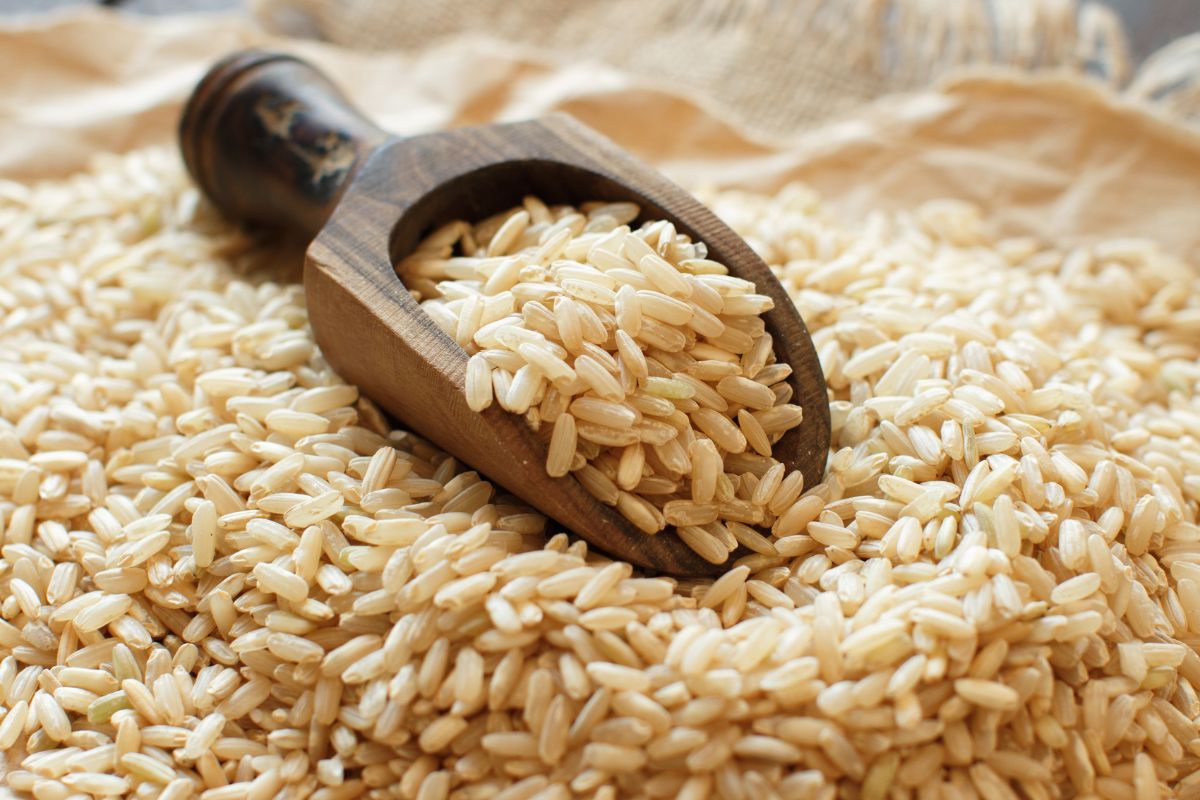
Brown rice is jam packed with vitamins and minerals that are essential for your wellbeing. It’s also versatile and can go with most meal options.
Brown rice contains antioxidants, B group vitamins, phosphorus and magnesium. It also has a high amount of selenium and is rich in fiber. When you eat brown rice, you may find that you feel a lot fuller afterwards.
Yes, brown rice can be eaten as a go-to side dish (I usually pair it with baked salmon for a quick weekday meal) but it’s more versatile than you think. Here are some meal ideas using Brown rice:
- Make extra and freeze: Brown rice is so versatile so when you’re making it, double your recipe and keep it in the fridge to use within three days. You can also freeze it
- Mexican rice with Amaranth: Combine brown rice with nutritional powerhouse Amaranth for a great side dish to any Mexican food meal
- Stir-fried Brown rice: Create a quick and flavorful stir-fry by sautéing cooked brown rice with an assortment of vegetables, lean protein, and your choice of stir-fry sauce
- Brown rice and black bean burrito bowl: Layer cooked Brown rice with black beans, sautéed chicken or beef/onions/sweet peppers, salsa, avocado slices, and sour cream
- Brown rice and lentil soup: Add cooked brown rice to a hearty lentil soup for added texture and nutrition. This is an easy way to take store-bought soup and add bulk, flavor, and nutrients
- Brown rice sushi rolls: Make your own sushi rolls using cooked and cooled brown rice as the filling instead of white sticky rice
- Brown rice breakfast bowl: My husband grew up with rice as part of his family’s breakfast rotation. Take leftover cooked and cooled brown rice, Greek yogurt, mixed berries, chopped nuts, and drizzle honey for a different take on yogurt and granola
- Brown rice and bean tacos: Use cooked brown rice as a base for flavorful bean tacos. Top with seasoned beans, lettuce, diced tomatoes, cheese, and salsa
Learn more about Rice here.
7. Rye

Whole Rye is full of nutrients and vitamins that are essential for your health!
Many researchers even say that the number of nutrients in one serving of rye is more than what you would expect from any alternative whole grain.
It’s jam packed with fiber and one serving only has around 100 calories in total.
Not only that but one serving of rye contains a whopping 50% of your daily recommended iron intake. It can be used in a variety of meals making it very versatile too.
If you are struggling about how to incorporate Rye into your diet, here is some inspiration:
- Rye hot cereal: Cook Rye flakes or whole Rye berries to create a hearty and nutritious breakfast hot cereal, oatmeal-style. Top it with sliced bananas, berries, and a drizzle of honey or maple syrup
- Open-faced Rye sandwich: Use a slice of rye bread as the base for an open-faced sandwich. Top with your favorite protein, hummus, avocado, cherry tomatoes, and a sprinkle of salt and pepper
- Smoked salmon Rye toast: Spread cream cheese or Greek yogurt on a slice of Rye bread and top with smoked salmon, red onion slices, capers, and dill
- Rye and vegetable salad: Create a flavorful salad by mixing cooked Rye with roasted or grilled vegetables, feta cheese, olives, and a light vinaigrette
- Rye berry stew: Make a hearty stew by simmering cooked rye berries with vegetables, beans, and a flavorful broth. Add herbs and spices for extra taste
- Rye breakfast parfait: Layer cooked and cooled rye with Greek yogurt, mixed berries, and a sprinkle of granola or chopped nuts
- Rye and mushroom risotto: Use cooked rye berries, sautéed mushrooms, onions, and vegetable broth. Finish with a touch of cream (or omit for less calories) and grated Parmesan
- Rye croutons: Cube rye bread and toast it to make crunchy croutons. Use them to top salads, soups, or creamy vegetable dishes
Learn more about Rye here.
Should I avoid grains to lose weight?
As with any food, it’s all about balance. One of the reasons I started coooking and baking with whole grains is because I was diagnosed with gestational diabetes. I was forced to start looking at ingredient labels and I was shocked at how processed most grain-based food was.
So it’s not about avoiding grains, it’s about avoiding processed grains, which is in most pre-packaged food. Learning how white or all-purpose flour is made and how easy it is to start to make the switch to 100% whole grains, you can enjoy the grains that our ancestors ate for thousands of years–almost unaffected by diabetes, heart disease, and other metabolic disorders brought on by our bad food options here in the United States.
I’ve written about this more so make sure to check out some other helpful articles as you continue your own personal journey of being a healthier version of you!
- Brown bread isn’t always whole grain – know the difference: For many years I thought if I bought brown bread at the grocery store, I was eating whole grains. Nope! Learn how to better read nutritional labels
- Switching to whole grain: A family-friendly guide: I talk through getting your family, especially your picky-eaters, on board with the whole grain switch
- The three rules of healthy whole grains: Learn the problem of modern day grains and why 100% whole grains are actually healthy for you, even if you’re trying to eat healthier
- Whole grains comparison chart: If you’re a bit overwhelmed with all the “whole grains” out there, I was there too! Here is an easy chart to help you figure out what is best for you.
Keep in mind: the benefits of grains far outweigh the problems. It’s about eating the right grains, from the right sources, cooked in the right way can actually help you to lose weight.
What grains are not good for weight loss?
An easy rule to follow is: 100% whole grains are great for anyone wanting to be healthier but refined grains are NOT. It’s best to stay away from any refined grains.
Eating these “grains” (which usually have the bran and germ removed, the part of the grain that is the most nutritious but also the part that makes profitability hard as grains with the bran and germ still included negatively impact shelf-stability) will help you to reach your daily recommended calorie intake, but they don’t come with any extra nutritional value.
Some grains to stay away from if you’re on a calorie-restricted diet:
- White rice: I actually love white rice and think it’s a great option, but if you’re restricting calories, opt for Brown Rice, Barley, Spelt, or even Amaranth. These are whole grain options which increases the amount of fiber and reducing the glycemic index
- Pearled Barley: I mentioned this above, but Pearled Barley is a form of Barley that has been processed to remove the tough, inedible outer hull and some of the bran layers. This results in a smoother, more refined grain that cooks faster and has a softer texture. However, because the outer layers are removed, pearled barley is slightly less nutritious compared to whole or hulled barley, as some of the dietary fiber and nutrients are lost in the process.
- Couscous: Couscous is actually a pasta product made from crushed Durum Wheat, so it’s not a whole grain. It’s often used in North African and Mediterranean cuisines. While it’s a quick-cooking and versatile option, it’s relatively low in fiber and some other nutrients compared to whole grains like quinoa, farro, or whole wheat.
- White bread: While not a whole grain, white bread is made from refined wheat flour, which means it has been stripped of much of its fiber and nutrients. It’s a calorie-dense food that lacks the nutritional benefits of whole grain bread. You can read more about white all-purpose flour here, which is used to make white bread
- Semolina: Similar to couscous, semolina is a refined wheat product often used to make pasta and certain types of baked goods. It’s lower in fiber and nutrients compared to whole wheat products
- Cornmeal: Cornmeal, especially the refined varieties, can be lower in nutritional value compared to whole corn or other whole grains. It’s often used in baking and as a coating for fried foods. Opt for fresh ground cornmeal that uses the entire corn kernel, usually available at local mills
Conclusion
Hopefully these 7 low-calorie grains can inspire you to not cut out grains when trying to cut back on calories.
When eaten as part of a balanced diet, these grains will help you to feel healthier when you eat them too. Don’t be afraid to try them out in different and unique recipes either.

